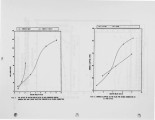| OCR Text |
Show PAPER NO.3 The reduction of NOx emissions from a fluidised bed combustor by staged combustion combined with ammonia additive injection B.M. Gibbs· S.F. Sibtain and T.F. Salam Department of Fuel and Energy INTRODUcnON The European Economic Community (EEC) is proposing to introduce legislation aimed at limiting NOx emissions, as well as the emissions of S02 and particulates, from coal fired boiler plants. As far as fluidised bed combustion (FBC) is concerned, only ft::surized fluidlsed bed combustors are likely to meet future EEC NOx emission ". ·ts. It is anticipated that NOx emissions from the present generation of atmospheric combustors, burmng large coals (6-25mm) in shallow beds, will need to be reduced by up to 50% in order to comply with these pending BEC NOx emission limits. This legislation is likely to apply to boilers and furnaces with outputs greater than 50 MW thermal input. Hence there is now considerable urgency to investigate and develop techniques to limit NOx emissions from atmospheric combustors burning large coals. Previous studies (1-3) have shown that NOx emissions from atmospheric combustors could be reduced by 30-60% if ammonia was injected into the freeboard. To date, ammonia injection is one method of NOx reduction that has been studied for shallow fluidised bed combustors burning large coals. However, a recent review on NOx emissions and control (4) showed that there are a number of other techniques that could potentially reduce N Ox emissions from fluidised bed combustors. Amongst these, the operation of a fluidised combustor in an air-staged mode (5-7) promises a potential reduction in NOx emissions. Air-staging aims at reducing NOx emissions by capitalising on the enhanced NOx destruction that occurs under sub-stoichiometirc conditions. In this operational mode the combustion air is separated into a primary air stream which constitutes the fluidising air supply to the bed and a second~ air stream that is injected higher up in the bed or freeboard. All the coal is injected mto the primary stage so that the bed is maintained at sub-stoichiometric conditions promoting NO destruction. Combustion is completed following the introduction of secondary air. The combustor is operated at overall excess air conditions, as in conventional operation. Previous investigations on air-staging of fluidised combustors(s) have achieved reductions of 50% or more but have been limited to crushed fuels «3mm) and relatively deep beds (0.6 - 1.Orn). A recent study has shown the feasibility of achieving a 50% reduction in NOx emissions at NH3/NO molar ratio of only 0.6: 1. However this was confined to an overall operating velocity of 2m/s 40% excess air level and at a fixed level of air sta~ng. The objective of this Investigation was to determine the effect of fluidising velOCIty and various levels of air staging on NOx emission leading to a better understanding of the reduction process and to the selection of the optimum operating condition. " The experimental investigation covered the following: (i) (ii) The effect of fluidising velocity. The effect of different levels of air staging (10-30%) "at various fluidising velocities. * Author for correspondence 1. |



















